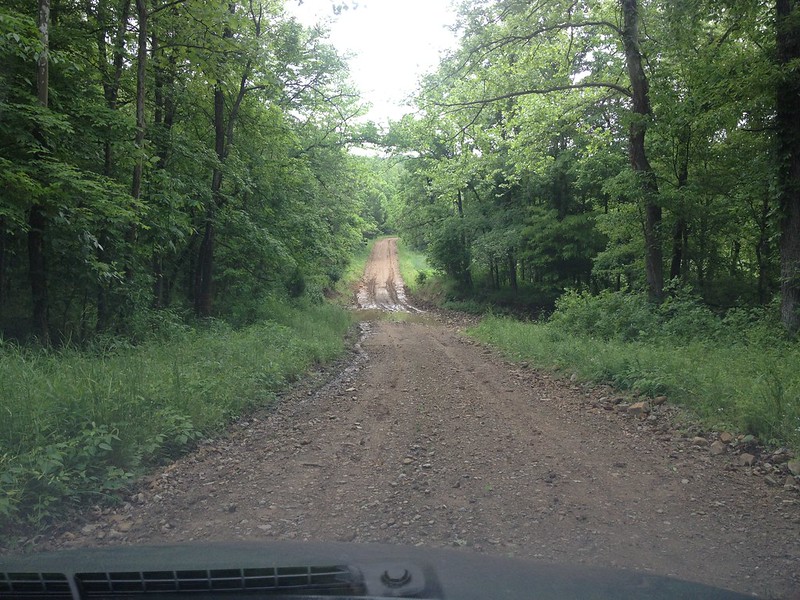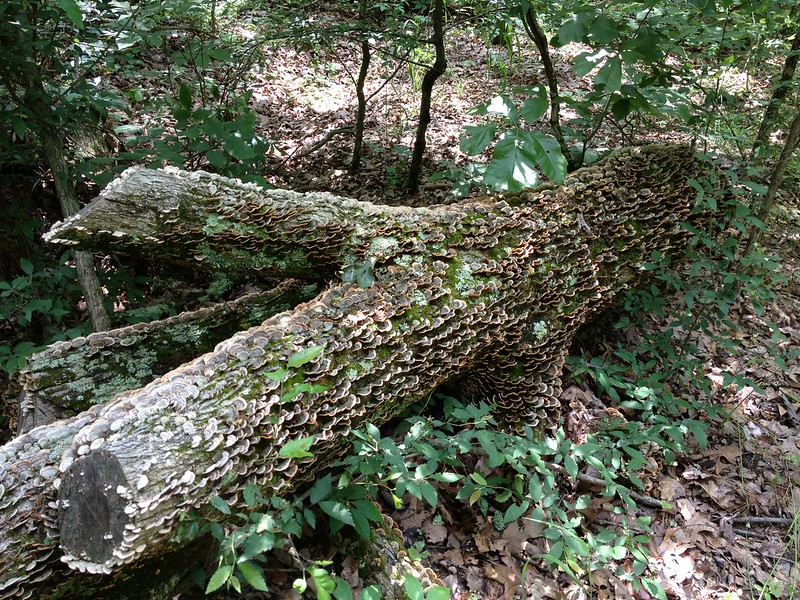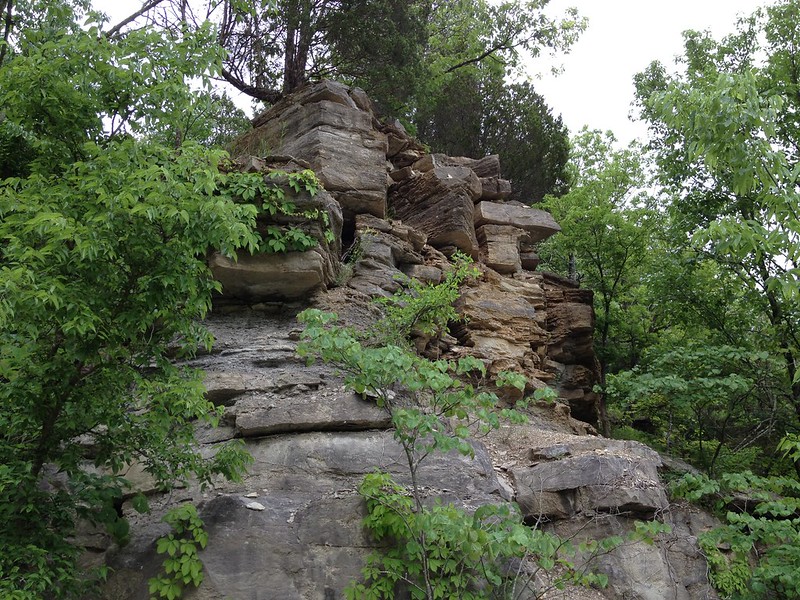Lusk Creek Wilderness Area (Indian Kitchen), Millstone Bluff Archaeological Area
Shawnee National Forest/Cache River road trip: Day 6
May 23, 2013
There’s a point in any trip when I start to feel like the greater part is behind me, and that all too soon I’ll be returning to the everyday world in which every day is more of the same, and there’s little to look forward to — no bends in the road, as Anne of Green Gables might say. Thursday, May 27, I began to look more behind than ahead so that I regretted what was past instead of anticipating what was to come. At least when we said good-bye for the final time to Willowbrook Cabins, Sheriff “Bob” (as I’d dubbed him) wasn’t on the road, ready to cut off unsuspecting tourists.
Our objective was Lusk Creek Wilderness Area, which wasn’t as easy to find as you’d think. As we drove in what we thought seemed a likely direction, we spotted a woman riding up and down the rolling hills on a bike. We saw her a couple more times as we went back and forth trying to find the road to Lusk Creek Canyon. By the time of the third sighting, she was walking the bike. We wondered where she was going and how many times more we would see her toiling over the hills.
Google Maps kept steering me toward what appeared to be a decent red dirt road with the promising name of Ragan Road. Not all dirt roads are created equal, and this one didn’t look bad at first. Soon, though, it began to throw an alarming number of rocks at the car. Then the mud and ruts began, and the Corolla’s two-wheel drive kicked in as J. struggled to keep it from getting stuck and I struggled to understand the map. The woman on the bike would have had a better chance of getting through than us.

After a half hour or more and a particularly difficult stretch of rocks, mud, and ruts, we stopped about 100 feet short of a low spot covered by water. I didn’t want to risk it, nor did he, and it wasn’t hard to figure out that this may not have been the right way. As we sat talking about the options, he glanced in the rearview mirror and exclaimed, “Darn it! Now I’ll have to move.” I asked why. “Look behind us.” Two men in Western gear sat astride two patient horses, and J. clearly thought we were in their way. We both got out, and J. tried to reassure them he would move it as quickly as possible.
“You’re fine,” one of the riders said. “We can go around. Do you need help?”
They explained that they’d been following us for a while and had been wondering where we thought we were going and how we thought we were going to get there in a Toyota Corolla. We told them we were looking for Lusk Creek Canyon, but we had started to figure out this wasn’t the best route, if it was a route at all. While praising J.’s driving skills in getting us this far on that road in that type of car, they told him they would guide him as he turned the car around. As J. maneuvered the car, the two men rode back and forth across the road, letting him know when he was getting too close to the edge.
“Do you hear what they’re saying when they want you to stop?” I asked, laughing.
“Not really. What?”
“WHOA! Just like he would say to his horse!”
With their guidance, we were able to get out. They couldn’t get us clear driving directions to Lusk Creek Canyon — they knew how to get there on horseback.

After driving a bit more, we found ourselves at Shawnee Mart in Eddyville, which seemed like a good place to stop, pick up cold drinks and snacks, and ask directions. By then it was midday, and the parking lot was nearly empty. As we pulled in, though, who should appear but the bicyclist, walking her wheels toward the store. We met her outside the entrance, and J. couldn’t resist asking if he could take a photo. He thought she sounded Australian, but I guessed (correctly) that her accent came from the south of England, although she originated in Scotland. She was riding (and walking) from Washington, D.C. to Oregon, if I remember right. I told the trail takes her conveniently through the only truly hilly part of the state. As I write this three months later, I wonder if or when she made it — and, of course, how she was able to do it at all. Carefree spirit or a fortunate soul with a trust fund? I’l never know.


The cashier at Shawnee Mart figured out what we were looking for. “You mean Indian Kitchen?” We’d seen signs for it several times over several days, but hadn’t known what it was. Not only is Indian Kitchen (aka Lusk Creek Canyon Nature Preserve) the scenic highlight of Lusk Creek Wilderness, but it’s not that far from Shawnee Mart. We’d spent the morning looking for something that was in front of us, if we’d only known (thank you, Google Maps). Then, when we went down the correct roads (the second called Indian Kitchen Road), we overshot it by a mile or two. There’s a good-sized, tree-shaded parking lot on the west side of the road, but we missed it, along with the trailhead sign.
Soon we decided it was wise to have bought waterproof hiking shoes because the trail was very muddy — the kind of mud that grabs your foot each time you set it down and, if you let it, sucks your tightly laced shoes right off your feet. It was the kind of mud that makes even a short walk exhausting. Judging from the water-logged ruts and holes, the trail is very popular with horse riders, too, as our friends on Ragan Road had hinted.
The skies turned cloudy as we walked, and we saw only a few people, mostly returning. Although someone told us Indian Kitchen wasn’t much further and that it was worth it (something said of nearly everything in Shawnee), by the time we reached the Indian Kitchen sign, I didn’t have much left — perhaps just enough for the muddy trip back to the car. I had to turn back. J. went a little further but not enough to get to Indian Kitchen. From the photos I’ve seen, we missed out on another beautiful spot.







Earlier in the day, I’d reserved space at Frog Holler Bed and Breakfast in Jonesboro, so that’s where we headed. Along the way, we came across Millstone Bluff Archaeological Area. One of the many marvelous things about the Shawnee National Forest/Cache River/southernmost Illinois region is that there’s not only hiking and horse trails, and fishing and swimming holes — there’s also history galore, from Indian cities and mounds to the Trail of Tears. Having stopped, though, we didn’t make it to the top of the bluff because it was getting dark, the mosquitoes were swarming (on me, mostly) and I was still in pain from the earlier exertion.





After four wonderful days in the eastern, less developed part of Shawnee, we crossed over to the western part in search of Frog Holler Lodge, which we found eventually. The man who came out seemed surprised to see us, and I was equally surprised when he said all their guests had arrived, and that I hadn’t made a reservation there. As we drove off, I went back to the guide I’d called them from, looked at the number I called on my iPhone — and realized I’d called the number below, which was the nearby Hidden Lake Bed & Breakfast. I had jumped down a line while trying to read across.
The bad news was that it’s more expensive, although not prohibitively so. The good news was that it’s a beautiful property with a truly hidden lake (down the hill from the buildings), the rooms are large and have a lot of features (many even have a Jacuzzi, which is just what my aching bones and muscles needed), the location is on a side road that leads into downtown Jonesboro, and the owners are charming. I’ve had mistakes turn out a lot worse than this!
We had to get dinner, so we were referred to Brick House Grill in Anna, where the service was slow but the food was good after another day of Shawnee adventures.

Comments
Lusk Creek Wilderness Area (Indian Kitchen), Millstone Bluff Archaeological Area — No Comments
HTML tags allowed in your comment: <a href="" title=""> <abbr title=""> <acronym title=""> <b> <blockquote cite=""> <cite> <code> <del datetime=""> <em> <i> <q cite=""> <s> <strike> <strong>